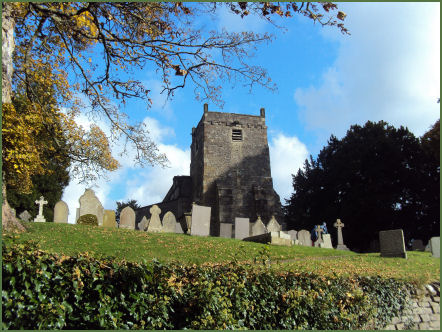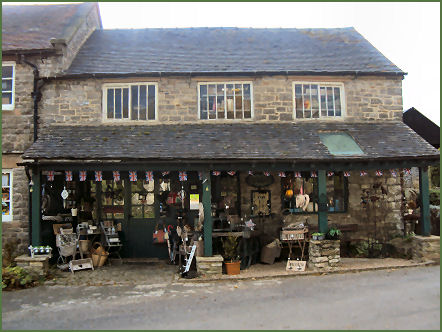Tissington
Grid Ref:- SK176523
The picture postcard village of Tissington, situated 3 miles north of Ashbourne in the Peak District National Park, is rightly regarded as one of the most picturesque of English villages with its pale limestone cottages enriched in Autumn by Virginia Creeper and yellow lichens.
Tissington Hall


The village forms part of the estate of Tissington Hall, owned by the aristocratic FitzHerbert family since 1465. An ancient settlement, Tissington is recorded in the Domesday Survey of 1086 as 'Tizinctun', it then had a population of about 100 and was owned by Henry de Ferrers, a Norman knight who fought at the Battle of Hastings. The name derives from the Anglo-Saxon 'Tidsige's farm/settlement'.
St. Mary's Church and Tissington Hall Well


The estate passed from the de Ferrers to the Savage family in the reign of King Henry I. On the death of the last male heir, William le Savage in 1259, it was divided between the families of the two joint heiresses, the Meynells and Edensors. The part of the estate owned by the Meynell's was acquired in marriage by Nicholas FitzHerbert in the 1460s. During the reign of the Tudor Queen Elizabeth I, Francis, the great-grandson of Nicholas, purchased the remainder from the heirs of Edensors. The state has remained in the ownership of the FitzHerbert's ever since.
Tissington Hall, the seat of the FitzHerbert family, stands proudly at the centre of the village. A fine Jacobean building, it was constructed in 1609 by Francis FitzHerbert, and replaced an earlier moated manor house. The spacious central entrance hall still retains its original panelling and neo-Gothic plasterwork and boasts an elaborate fireplace dating from around 1750. The ornately carved staircase is also original. The drawing room on the upper floor has handsome panelling with fluted pilasters. There is also a 10 acre garden and arboretum. The Hall is open to the public at specified times of the year.
The village stream and Tissington Hardware Shop


The Parish Church of St Marys dates back to Norman times, probably being built shortly after 1100, although extensively restored in Victorian times, there is still plenty of Norman work to be seen inside, including the south doorway, the chancel arch and the 11th century tub-shaped font. The church also contains many monuments to the Fitzherbert family. St. Mary's is built on a mound which archeological evidence suggests is an earthwork belonging to an Iron Age fortification.
The old village school now serves as tea-rooms, above the doorway the carved initials of Frances Fitzherbert can be seen. Adjacent to the school is a large duckpond. A stream runs through the village street, culverted for most of its length and surfacing near the Hall Well to run past St. Mary's church and on down to the village pond.
The Tissington Trail, which commences just off the car park, runs for 13 miles and follows the line of the former Ashbourne to Buxton railway line. Cycle hire is available in season.
Well Dressing at Tissington
 The unique Derbyshire custom of Well Dressing is said to have begun at Tissington in 1340. There are six wells dressed around the village each year during the Annual Well Dressing Festival which runs for seven days from Ascension Day.
The unique Derbyshire custom of Well Dressing is said to have begun at Tissington in 1340. There are six wells dressed around the village each year during the Annual Well Dressing Festival which runs for seven days from Ascension Day.
The origins of this exclusively Derbyshire custom are lost in the mists of time. It is thought to have developed from the old pagan custom of making sacrifice to the gods of wells and springs to ensure a continued supply of fresh water. The fact that many well dressings have a 'well queen' does suggests echoes of ancient spring fertility rites.
However, some sources state the practice began after the Black Death of 1348-9, a great plague which claimed the lives of a third of the population of England. Some villages such as Tissington were left untouched by the disease. The inhabitants attributed this to their clean water supply and gave thanks by 'dressing' the village wells.
The custom of well dressing had almost died out by the early years of the twentieth century, but was resumed in the 1920s and 1930s. The custom has since been revived, primarily for the tourist industry, in numerous villages and small towns in Derbyshire, Cheshire, Staffordshire and South Yorkshire.
The construction of the well dressings is an art requiring skill. Wet clay is spread a few inches thick across a wooden backing board, a design is 'pricked out' in the clay using a paper pattern and then petals and other items are positioned to form the design. After the 'dressing' the well it is blessed.
Ilam Park Beautiful Ilam Country Park is situated at the Peak District village of Ilam to the north west of Ashbourne. The park covers 158 acres (0.64 km2) on both sides of the River Manifold.
Dovedale, a dramatic limestone ravine, with its mpressive rock outcrops and tranquil woodlands is arguably the prettiest of the dales in the Peak District National Park and is owned by the National Trust.
Biddulph Grange, one of Britain's most exciting and unusual gardens, was created by the horticulturalist James Bateman (1811–1897), for his large collection of plants from around the world.
Haddon Hall near Bakewell, is an architectural gem. Dating back to the eleventh century, the hall has been described as "the most complete and most interesting house of [its] period", it is the finest example of a medieval manor house currently in existence in England.
